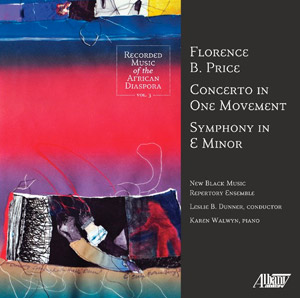 This was an unexpected pleasure: "Classical Lost and Found: Florence B. Price Rediscovered," from Bob McQuiston of NPR Classical (via Robert Loerzel and the Chicago Philharmonic), a brief piece about the Arksansas native and longtime Chicagoan who was the first black woman to have a symphony performed by a major orchestra: her Symphony in E Minor, which was premiered by the Chicago Symphony Orchestra in 1933. McQuiston's writing on the occasion of the symphony's late-2011 recording by the New Black Music Repertory Ensemble of Columbia College.
This was an unexpected pleasure: "Classical Lost and Found: Florence B. Price Rediscovered," from Bob McQuiston of NPR Classical (via Robert Loerzel and the Chicago Philharmonic), a brief piece about the Arksansas native and longtime Chicagoan who was the first black woman to have a symphony performed by a major orchestra: her Symphony in E Minor, which was premiered by the Chicago Symphony Orchestra in 1933. McQuiston's writing on the occasion of the symphony's late-2011 recording by the New Black Music Repertory Ensemble of Columbia College.
Price grew up in Little Rock, the daughter of one of a handful of black dentists in the country—"a dozen or so," Barbara Garvey Jackson estimates in a 1977 biographical sketch. His practice was originally in Chicago, but it was wiped out in the Great Fire of 1871, and he moved south to teach while re-establishing his practice, though an oil painting of his was displayed at the Columbian Exposition. Living in Little Rock brought Price into contact with a local legend, Charlotte Andrews Stephens, whose teaching career spanned seven decades and included as students not only Price but William Grant Still, probably the greatest of the early African-American classical composers (by "greatest" I sort of mean "my favorite").
Still went on to do arrangements for W.C. Handy, study under Edgard Varèse, and end up in the movie business (where he did the arrangements for Pennies from Heaven). Price taught briefly at Clark University, but returned home to Little Rock to marry a lawyer, a member of Scipio Africanus Jones's law firm; Price's husband worked on the defense of the "Elaine Twelve" following the Elaine Race Riot of 1919.
The racial violence of the post-World War I south eventually drove Price and her husband north, where she continued her musical study and raised the family's two children. Price also taught; one of her students was Margaret Bonds, who would also win the Wanamaker Prize that brought Price's music to the attention of the CSO, and go on to considerably more fame than Price herself.
Price is reasonably well-known within the area; there's an elementary school named after her at 43rd and Drexel, and I've occasionally heard her music around, such as on the Pipe Dreams organ-music show that WFMT carries. But she never had the success of family friend William Grant Still or her student, Bonds. Some of this can probably be attributed to her gender—whereas Still traveled the world and whose music reflects it, Price followed her husband and raised two children, and when her marriage fell apart she was left in financial straits with two mouths to feed. But Price was also older than both Still and Bonds, and you can hear it in her music. As then-New York City Opera dramaturg Cori Ellison writes, Price is considered a bit boring for a composer active during a tumultous period in the genre:
Yet after Price's death in 1953, most of her compositions were lost or forgotten, and remain largely unknown and unpublished.
Why? Listening to the philharmonic's recording answers this question. Price's firmly tonal, sweepingly melodic, and lushly romantic music was utterly untouched by the spiky, atonal aesthetics of the twentieth century. Too good a student of the old-fashioned white males who taught her, Price was branded "conservative."
Ellison, listening to Price's third symphony, hears Gershwin in her work; listening to the symphony that the CSO premiered, McQuiston hears Dvorák:
The opening movement has melodies and rhythms typically found in Afro-American folk music, and recalls Dvorák's New World Symphony, while the following slow movement features a moving hymn tune of Price's design.
Both concluding movements are fast and return to the juba dance concept. They contain hints of fiddles and banjos, antic slide whistle effects, and a recurring three-against-two melody which end this loveable work on a whimsical note.
I hear some Aaron Copland (who was also doubly an outsider, and who led his fairly conservative arrangements with catchy, hummable vernacular melodies). That should triangulate it for you: "lushly romantic" symphonic music that uses folk rhythms and melodies to create a distinctively American landscape. I'm both surprised and not that she's not better known—her conservative sensibilities mean she's not as storied as her near-contemporaries, but they also make her comparatively accessible, and well worth a listen.


